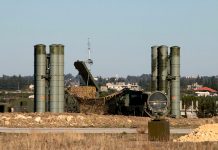
The U.S. Air Force has completed the environmental assessment and legal review process, officially authorizing the temporary relocation of 17 B-1B Lancer bombers and roughly 800 personnel from Ellsworth Air Force Base in South Dakota to Grand Forks Air Force Base in North Dakota. This move, which is set to begin in December, marks a significant logistical and operational development as the Air Force modernizes its facilities in preparation for the arrival of the B-21 Raider bomber.
The relocation, expected to last around 10 months, will allow for crucial runway upgrades at Ellsworth, enabling it to support the B-21 Raider, America’s next-generation long-range strike aircraft. “This project showcases the Air Force’s dedication to maintaining readiness for the B-21 Raider while preserving Ellsworth’s operational capacity,” said Col. Derek Oakley, commander of the 28th Bomb Wing. These upgrades highlight the strategic importance of Ellsworth, which will be the first operational home for the B-21.
While stationed at Grand Forks, the B-1B fleet will remain fully operational, continuing to support ongoing missions. Maintenance teams will perform daily inspections, repairs, and manage deployments from the temporary location. Larger-scale maintenance requiring specialized facilities will take place at Dyess Air Force Base in Texas, utilizing the Air Force’s distributed maintenance network to ensure mission readiness.
The move also represents a unique blending of capabilities, as Grand Forks, traditionally associated with unmanned aerial systems like the RQ-4 Global Hawk, will now host the B-1B bombers. “This relocation demonstrates the Air Force’s adaptability and dedication to seamless operational integration,” remarked Col. Tim Monroe, commander of the 319th Reconnaissance Wing. “By combining the expertise of the B-1 and unmanned systems communities, we enhance our collective ability to respond to emerging global threats.”
This temporary shift will bring noticeable changes to the surrounding communities. Residents near Ellsworth will see increased construction activity, while those near Grand Forks can expect more military transport operations and the sound of high-performance aircraft in the skies.
Though the relocation is temporary, it reflects broader strategic realignments within the Air Force. The B-1B, a key asset in recent military operations including precision strikes in the Middle East, will remain mission-ready while Ellsworth undergoes necessary infrastructure upgrades to accommodate the B-21 Raider. The B-21, expected to arrive in the mid-2020s, will redefine the U.S. strategic deterrence and strike capabilities.
The B-1B Lancer, a critical component of the U.S. strategic bomber fleet, was originally designed during the Cold War and has evolved to meet modern defense needs. Its long-range, supersonic capabilities and ability to carry a variety of munitions make it essential to the U.S. military’s global strike capabilities. Although its nuclear delivery role was removed under the START I treaty, the B-1B remains a powerful conventional strike platform, capable of carrying a maximum payload of 75,000 pounds.
The bomber’s advanced avionics and mission systems include radar and electronic countermeasures designed to penetrate enemy air defenses and neutralize threats. It also features a flexible weapons bay to accommodate various munitions, including Joint Direct Attack Munitions (JDAMs) and Joint Air-to-Surface Standoff Missiles (JASSMs).
Recent upgrades such as the Integrated Battle Station (IBS) modernization have improved the B-1B’s communication, situational awareness, and digital cockpit displays, ensuring its continued relevance in modern warfare. Despite the arrival of the B-21 Raider, the B-1B will remain a crucial part of the Air Force’s fleet, bridging the gap between legacy bombers and next-generation capabilities.
The B-1B plays a complementary role to the B-52 Stratofortress and B-2 Spirit, offering unmatched conventional strike capacity and supporting the U.S. military’s global deterrence strategy. Its ability to deploy precision-guided munitions over long distances and quickly respond to evolving threats reinforces the credibility of U.S. defense commitments to allies and its deterrence posture.




